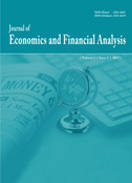URI: https://ojs.tripaledu.com/jefa/article/view/103/109
The Exchange Rate Pass-Through: Evidence of South Africa
DOI: http://dx.doi.org/10.1991/jefa.v9i1.a75
Abstract
Keywords
JEL Classification
Full Text:
References
Ajilore, T., & Ikhide, S. (2013). Monetary policy shocks, output and prices in South Africa: A test of policy irrelevance proposition. The Journal of Developing Areas, 47(2), 363–386.
Aron, J., Macdonald, R., & Muellbauer, J. (2014). Exchange rate pass-through in developing and emerging markets: A survey of conceptual, methodological and policy issues, and selected empirical findings. Journal of Development Studies, 50(1), 101–143. https://doi.org/10.1080/00220388.2013.847180
Auer, R.A. (2015). Exchange rate pass‐through, domestic competition, and inflation: Evidence from the 2005–08 revaluation of the Renminbi. Journal of Money, Credit and Banking, 47(8), 1617–1650. https://doi.org/10.1111/jmcb.12254
Bahmani-Oskooee, M., & Xi, D. (2012). Exchange rate volatility and domestic consumption: Evidence from Japan. Economic Systems, 36(2), 326–335. https://doi.org/10.1016/j.ecosys.2011.10.004
Brooks, C. (2019). Introductory econometrics for finance (4th ed.). Cambridge University Press. https://doi.org/10.1017/9781108524872
Caselli, F.G., & Roitman, A. (2019). Nonlinear exchange‐rate pass‐through in emerging markets. International Finance, 22(3), 279–306. https://doi.org/10.1111/infi.12344
Ca’Zorzi, M., Hahn, E., & Sanchez, M. (2007). Exchange rate pass-through in emerging markets (Working Paper Series No. 739). European Central Bank. https://doi.org/10.2139/ssrn.999627
Cheikh, N.B., & Rault, C. (2017). Investigating first-stage exchange rate pass-through: Sectoral and macro evidence from euro area countries. The World Economy, 40(12), 2611–2638. https://doi.org/10.1111/twec.12542
Chinn, M., Ferrara, L., & Mignon, V. (2014). Explaining US employment growth after the Great Recession: The role of output–employment non-linearities. Journal of Macroeconomics, 42, 118–129. https://doi.org/10.1016/j.jmacro.2014.07.00
Choudhri, E.U., & Hakura, D.S. (2006). Exchange rate pass-through to domestic prices: Does the inflationary environment matter? Journal of International Money and Finance, 25(4), 614–639. https://doi.org/10.1016/j.jimonfin.2005.11.009
Edwards, S., & Cabezas, L. (2022). Exchange rate pass-through, monetary policy, and real exchange rates: Iceland and the 2008 crisis. Open Economies Review, 33(4), 741–774. https://doi.org/10.1007/s11079-021-09665-9
Ghosh, A., & Rajan, R.S. (2009). Exchange rate pass-through in Korea and Thailand: Trends and determinants. Japan and the World Economy, 21(1), 55–70. https://doi.org/10.1016/j.japwor.2007.09.001
Gopinath, G. (2015). The international price system (NBER Working Paper No. 21646). National Bureau of Economic Research. https://doi.org/10.3386/w21646
Goldberg, L.S., & Campa, J.M. (2010). The sensitivity of the CPI to exchange rates: Distribution margins, imported inputs, and trade exposure. The Review of Economics and Statistics, 92(2), 392–407. https://doi.org/10.1162/rest.2010.11443
Gujarati, D.N., & Bernier, B. (2004). Économétrie. De Boeck.
Gust, C., Leduc, S., & Vigfusson, R. (2010). Trade integration, competition, and the decline in exchange-rate pass-through. Journal of Monetary Economics, 57(3), 309–324. https://doi.org/10.1016/j.jmoneco.2010.02.004
Hyder, Z., & Shah, S. (2004). Exchange rate pass-through to domestic prices in Pakistan (Working Paper No. 5). State Bank of Pakistan.
Ihrig, J.E., Marazzi, M., & Rothenberg, A.D. (2006). Exchange-rate pass-through in the G-7 countries (International Finance Discussion Paper No. 851). Federal Reserve Board.
Jasova, M., Moessner, R., & Takats, E. (2016). Exchange rate pass-through: What has changed since the crisis? BIS Working Papers No. 583. Bank for International Settlements.
Johansen, S. (1991). Estimation and hypothesis testing of cointegration vectors in Gaussian vector autoregressive models. Econometrica, 59(6), 1551–1580. https://doi.org/10.2307/2938278
Kabundi, A., & Mbelu, A. (2018). Has the exchange rate pass‐through changed in South Africa? South African Journal of Economics, 86(3), 339–360. https://doi.org/10.1111/saje.12207
Karoro, T.D., Aziakpono, M.J., & Cattaneo, N. (2009). Exchange rate pass-through to import prices in South Africa: Is there asymmetry? South African Journal of Economics, 77(3), 380–398. https://doi.org/10.1111/j.1813-6982.2009.01215.x
Kim, H., Lin, Y., & Thompson, H. (2021). Exchange rate pass-through to consumer prices: The increasing role of energy prices. Open Economies Review, 32(2), 395–415. https://doi.org/10.1007/s11079-020-09594-2
Patel, N., Wang, Z., & Wei, S.J. (2019). Global value chains and effective exchange rates at the country-sector level. Journal of Money, Credit and Banking, 51(S1), 7–42. https://doi.org/10.1111/jmcb.12613
Pierdzioch, C., Reid, M.B., & Gupta, R. (2016). Forecasting the South African inflation rate: On asymmetric loss and forecast rationality. Economic Systems, 40(1), 82–92. https://doi.org/10.1016/j.ecosys.2015.10.001
Pollard, P.S., & Coughlin, C.C. (2004). Size matters: Asymmetric exchange rate pass-through at the industry level (Working Paper No. 2004-013). Federal Reserve Bank of St. Louis.
Rebucci, A. (2010). Estimating VARs with long stationary heterogeneous panels: A comparison of the fixed effect and the mean group estimators. Economic Modelling, 27(5), 1183–1198. https://doi.org/10.1016/j.econmod.2010.04.011
Romer, D. (1993). Openness and inflation: Theory and evidence. The Quarterly Journal of Economics, 108(4), 869–903. https://doi.org/10.2307/2118453
Schröder, M., & Hüfner, F.P. (2002). Exchange rate pass-through to consumer prices: A European perspective (ZEW Discussion Paper No. 02-20). ZEW – Leibniz Centre for European Economic Research.
Sims, C.A. (1980). Macroeconomics and reality. Econometrica, 48(1), 1–48. https://doi.org/10.2307/1912017
Sovbetov, Y. (2018). Factors influencing cryptocurrency prices: Evidence from Bitcoin, Ethereum, Dash, Litecoin, and Monero. Journal of Economics and Financial Analysis, 2(2), 1–27. https://doi.org/10.1991/jefa.v2i2.a16
Taylor, J.B. (2000). Low inflation, pass-through, and the pricing power of firms. European Economic Review, 44(7), 1389–1408. https://doi.org/10.1016/S0014-2921%2800%2900037-4
Van der Merwe, E.J. (2004). Inflation targeting in South Africa. South African Reserve Bank.

This work is licensed under a Creative Commons Attribution-NonCommercial-NoDerivatives 4.0 International License.


